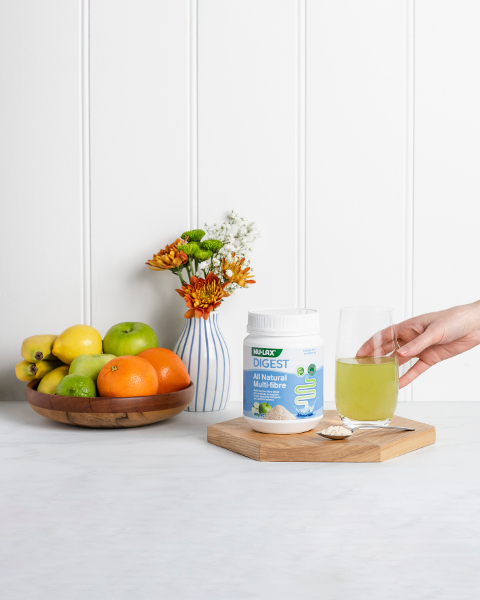5 Reasons Why Dietary Fibre is Essential for Menopausal Women
Hot flashes, night sweats, low mood, and stubborn weight gain – most of us dread the onset of menopause and the changes it brings.
Is there a simple way to embrace menopause and navigate the symptoms so we can thrive during this stage of our lives?
We spoke to nutritionist Brittany Darling (pictured below) about how dietary fibre may be the secret and the essential reasons we should consume a high-fibre diet.
What is Dietary Fibre?
Firstly, let’s understand what dietary fibre is before delving into its benefit for perimenopausal and menopausal women. “Fibre is a type of carbohydrate found in plant-based foods that your body can’t digest”, says Darling.
Several forms of fibre are beneficial to our health, including soluble fibre, insoluble fibre, prebiotic fibres, and viscous gel-forming fibre.
“It’s recommended for women to eat 25g of dietary fibre a day[i], but most aren’t acquiring sufficient fibre[ii]”, explains Darling. “Making conscious tweaks to your diet to include more plant foods can help you meet your needs and manage the transition through menopause. However, women have a tendency to be on-the-go, so I find supplementing can be very effective.”
Nu-Lax Natural Multi-Fibre is one dietary supplement Darling recommends as it combines soluble, insoluble and prebiotic fibres into a supportive powder. “Focusing on increasing your dietary fibre is essential for all of us, particularly women in their 40s and beyond”.


5 Reasons Why Dietary Fibre is Essential for Menopausal Women
- Helps to manage your weight
Dietary fibre helps to regulate your appetite and increase the sensation of fullness, explains Darling. “Increasing your dietary fibre can inadvertently help you manage your weight, something menopausal women often struggle with. It also helps to balance your blood sugar levels, reducing your risk of metabolic syndrome.”
- Keeps your digestion happy
“Menopausal women often experience a change in digestion as their metabolic function slows down”, says Darling. “This can result in bloating, flatulence, and irregular bowel movements.” Increasing your fibre will help keep your digestive system functioning optimally.
- May reduce the risk of fractures
Menopausal women may experience a decrease in their bone density which in turn, increases the risk of fractures[iii]. Lignans, compounds found in plant foods such as vegetables and nuts, along with dietary fibres have been found to lower the risk of hip fractures and could prove beneficial for overall bone health[iv].
- Effective in reducing cholesterol
Changes in female hormone levels can result in changes in cholesterol levels, increasing cardiovascular disease risk in menopausal women[v]. Regular consumption of fibre, particularly soluble fibre, is linked with a reduction in total and LDL cholesterol levels, explains Darling.
- May lower the risk of metabolic disorders
Menopause has been associated with various metabolic changes due to hormone changes such as decreased oestrogen levels and increased androgen levels[vi]. “Metabolic syndrome increases your risk of many health problems including diabetes, stroke and health disease,” says Darling. “Lifestyle and diet interventions, including adequate fibre intake, are vital in preventing metabolic disorders and improving overall health as we transition through this life stage.”
Thank you for your time Brittany – this has been so helpful, and I’ve learned a thing or 2. If you need more fibre in your diet, or just want to make things a little more regular, Nu-Lax is a delicious, easy to take dietary fibre supplement. I’ve been using it for 3 weeks, and I feel so much better. For more about Nu-Lax, click here.
Article References:
[i] Fibre | Nutrition Australia https://nutritionaustralia.org/fact-sheets/fibre-2/
[ii] Fayet-Moore, F., Cassettari, T., Tuck, K., McConnell, A., & Petocz, P. (2018). Dietary Fibre Intake in Australia. Paper I: Associations with Demographic, Socio-Economic, and Anthropometric Factors. Nutrients, 10(5), 599. https://doi.org/10.3390/nu10050599
[iii] Md Isa ML, Mohd Hatta NNKN, Nurumal MS, Sharifudin MA. Fracture Risk Factor in Post-Menopausal Women with Deterioration of Bone Density. Int J Prev Med. 2022 Apr 27;13:80. doi: 10.4103/ijpvm.IJPVM_286_20. PMID: 35706861; PMCID: PMC9188893.
[iv] Liu Z, Chen B, Li B, Wang C, Li G, Cao W, Zeng F, Chen Y. Greater Consumption of Total and Individual Lignans and Dietary Fibers Were Significantly Associated with Lowered Risk of Hip Fracture—A 1:1 Matched Case–Control Study among Chinese Elderly Men and Women. Nutrients. 2022; 14(5):1100. https://doi.org/10.3390/nu14051100
[v] Prabakaran S, Schwartz A, Lundberg G. Cardiovascular risk in menopausal women and our evolving understanding of menopausal hormone therapy: risks, benefits, and current guidelines for use. Ther Adv Endocrinol Metab. 2021 Apr 30;12:20420188211013917. doi: 10.1177/20420188211013917. PMID: 34104397; PMCID: PMC8111523.
[vi] Ko SH, Kim HS. Menopause-Associated Lipid Metabolic Disorders and Foods Beneficial for Postmenopausal Women. Nutrients. 2020 Jan 13;12(1):202. doi: 10.3390/nu12010202. PMID: 31941004; PMCID: PMC7019719.


